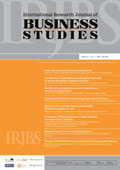Article Metrics |
|
|
Herding Behavior in Indonesian Investors
Abstract
This research attempts to investigate the herding behavior of the companies that invested in IDX LQ45 Index during 2014 through 2016. Herd behavior is the tendency of investors to follow other investors actions in the market. LQ45 was chosen as it comprises the most heavily-traded stocks of the Indonesian Stock Exchange. This research used Vector Autoregressive model to determine the effects of size and market return on the herding behavior. The Granger causality test suggests that there are dynamic interactions: (i) between size and herding behavior; and (ii) between market return and herding behavior. In addition, Variance Decomposition and Impulse Response reveal that market capitalization (size) has variable of the greater role in defining herding behavior, compared to that of market return.
Keywords: Herding Behavior, LQ 45, stock index, Vector Autoregression (VAR)
Full Text:
References
Beaver, William H. 1968. The Information Content of Annual Earning Releases: A Trading Volume Approach. Supplement to journal of Accounting Research, 67-92
Bikchandani, S. & Sharma, S. (2001). Herd Behavior in Financial Markets. IMF Staff Papers, 47(3), 279-310. Retrieved September 19, 2016,
https://www.imf.org/external/pubs/ft/wp/2000/wp0048.pdf
Brigham, Eugene F & Houston, Joel F. (2006). Fundamentals of Financial Management: Dasar-Dasar Manajemen Keuangan (10th ed.). Jakarta: Salemba Empat
Brunnermeier, Markus K. (2001). Asset Pricing under Asymmetric Information. Oxford University Press
Chang, Cheng, & Khorana. (2000). An Examination of herd behavior in equity markets: an international perspective. Journal of Banking and Finance, 24, 1651-1679
Christie, W. G. & Huang, R. D. (1995). Following The Pied Paper: Do Foreign Individual Returns Herd Around the Market. Journal of Financial Analyst, 31-37
Devenow, Andrea & Welch, Ivo. 1996. Rational Herding in Financial Economics. Journal of European Economic Review 40, 603-615
Fama, Eugene. (1970). Efficient Capital Markets A review of theory and empirical work. Journal of Finance, 25 (2)
Gilovich, Thomas & Griffin, Dale. (2002). Introduction Heuristics and Biases: Then and Now. The Psychology of Intuitive Judgement. Cambridge University Press: 1-18
Gutierrez, Roberto C., & Kelley, Eric K. (2009). Institutional Herding and Future Stock Returns. Journal of Finance. Retrieved September 20, 2016, https://www.researchgate.net/profile/Eric_Kelley3/publication/228666518_Institutional_Herding_and_Future_Stock_Returns/links/53da607b0cf2e38c63368880.pdf
Harris, L. (2003). Trading and Exchanges: Market Microstructure for Practitioners. Oxford University Press
Hirshleifer, David & Teoh, Siew Hong. (2003). Herd Behavior and Cascading in Capital Markets: A Review and Synthesis. European Financial Management 9, 25-66
Mabrouk, H.B. & Mohamed, Fakhfekh. (2013). Herding during Market Upturns and Downturns: International Evidence. Journal of Applied Finance, 19 (2)
Kahneman, D. (2003). Maps of bounded rationality: Psychology for behavioral economics. The American Economic Review 93, 1449-1475
Kahneman, D. & Tversky, A. (1979). Prospect theory: an analysis of decision-making under risk. Journal of Econometrica, 47 (2), 263291
Kremer, Stephanie & Nautz, Dieter. (2011). Short-term Herding of Institutional Traders: New Evidence from the German Stock. European Financial Management, 19, 730-746
Lakonishok, Shleifer, A., & Vishny, R. W. (1992). The impact of institutional trading on stock prices. Journal of Financial Economics, 32, 2344
Lintner, G. (1998). Behavioral Finance: Why Investors Make Bad Decisions. The Planner, 13 (1), 7-8
Ramli, I., Agoes, S., & Setyawan, I. R. (2016). Information Asymmetry and The Role of Foreign Investors in Daily Transactions During the Crisis: A Study of Herding in The Indonesian Stock Exchange. The Journal of Applied Business Research, 32 (1), 269-288
Ricciardi, V. & Simon, H. K. (2000). What is Behavior in Finance?. Business, Education, and Technology Journal, Fall: 1-9
Ritter, Jay R. (2003). Behavioral Finance. Pasific-Basin Finance Journal, 11, 429- 437
Shah, Anuj K. & Oppenheimer, Daniel M. (2008). Heuristics Made Easy: An Effort-Reduction Framework. Psychological Bulletin, 134, 207-222
Teh, Lilyn L. & Bondt, Werner F. (1997). Herding Behavior and Stock Returns: An Exploratory Investigation. Swiss Journal of Economics and Statistics, 133, 293-324
Testa, A. (2012). Path-Dependent Behavior with Asymmetric Information about Traders Type. Discussion Paper. University of Bonn, 1-36
Widarjono, Agus. (2007). Ekonometrika Teori dan Aplikasi. Yogyakarta: Ekonisia FE UII
Copyright (c) 2018 Sumani sumani
International Research Journal of Business Studies has been covered by the following services: | ||||||||||||||||||||||||
|




















